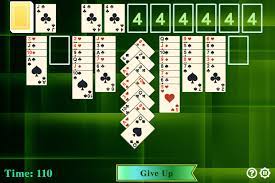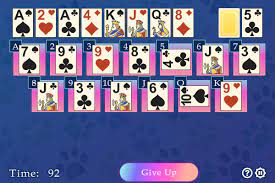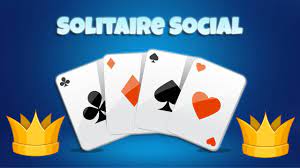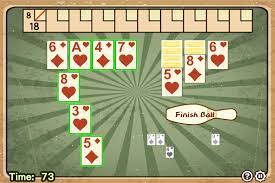- About Solitaire
The above game is Klondike Solitaire, also more commonly known as Solitaire. It is a type of card games played by one person, Solitaire can be played offline on a computer or with a deck of standard cards. You can also play online in Solitaire 247.
The term "solitaire" is also used for any single-player card related activities such as building card houses, flipping cards into a hat, and arranging them into magic squares.Solitaire can seem confusing at first, but it’s easy and fast-paced once you get the hang of it. The game need concentration and skill using a set layout tiles, pegs or stones.You can play this game for free, together with other famous card games such as Freecell, Spider Solitaire, Tri Peaks and Pyramid Solitaire.
- History of Solitaire
History of Solitaire has gone through many stages. The first indication of playing cards was in the 10th century in China. They achieved recognition in Italy and Spain in the 1370s, and a version of wood-block printing was emerged in Germany in early 15th century.
Solitaire is often referred to patience in some countries like France, England and Poland, so card solitaire was considered to initiate from the 18th century in Baltic area of Europe. In this stage, the game of solitaire has many names. It is often called "Patience," especially in Britain. In France, the game is sometimes called "Success". Other languages, such as Danish, Norwegian and Polish often use the word "Kabal" or "Kabala" to describe these games.
 The first commercial Solitaire game for computer playing was Solitaire Royale in 1987, but the real breakthrough of the game was in 1988 when Microsoft added the game to Windows 3.0. Wes Chery is the person who initially developed this game, and the design of the cards is Susan Kare.
The first commercial Solitaire game for computer playing was Solitaire Royale in 1987, but the real breakthrough of the game was in 1988 when Microsoft added the game to Windows 3.0. Wes Chery is the person who initially developed this game, and the design of the cards is Susan Kare.
Over the past 30 years, with the explosion of the Internet, Solitaire has been developed many more different variations: Klondike, Spider, Freecell, Pyramid, Forty Thieves, Scorpion, Yukon, Tripeaks, Emperor … There are more than 100 distinctly individual solitaire games, with that number reaching more than 1,000 when you consider minor variations.
- How to play solitaire (Solitaire Rules)?
Winning the game involves strategy, skill and a little luck!
Element of a Solitaire (Klondike)
Tableau: deal out 28 cards into 7 piles: the first pile (left to right) includes one card, and each subsequent pile has one more. All cards are face down except for the top one.
Stock pile: includes 24 cards that aren't dealt on the starting tableau.
Waste pile: is beside the stock pile. Each time you click on the stock, one or three cards will be dealt from the stock to the waste.
Foundation: are upper 4 piles, each pile is built up by one suit from Ace to King
Object of the Game
The goal of this game is to move all cards to the Foundation piles. Each pile represents a suit (hearts, clubs, etc.). They must be stacked by suit and in order, starting with the Ace, then the 2, 3, 4... ending with the Queen and then King.
Gameplay
Lay out 7 cards in a row – face down excluding the first card. Then put the eighth card face up on the second card in the row, and then complete the row with face-down cards. Place a face-up card on the third pile, and finish off the row in the same way. Continue until you have a face-up card on every pile.
Aces are low in this game. Square up the piles before playing. Make sure to put the Aces above the Tableau in the Foundation piles.
First, look over the Tableau carefully. Move any cards that you can to the Foundations. Aces first and any cards you can build on them. Only the face-up cards are available for this building, and only if they are exposed cards of the pile. Cards in the appropriate suit are then played on the aces in sequence - the two, then the three, and so on - as they become available.
Then you can build down-ward in alternating colors. Every time you move a face-up card, you need to turn up the face-down card beneath it, face-up. When there are no more face-down cards in a pile, you have a space. Spaces can be filled by any available King.
Once you’ve made all the moves you can, start going through the stock pile one by one or three by three, looking for more cards to build onto the foundations and the Tableau. If you can’t place the card, it goes face up onto a Waste pile, and the top card of the Waste pile is available for play.
You can also watch following video to get a step-by-step explanation of how to play a game:
New Games
-
 Trepeaks Solitaire Holiday
Trepeaks Solitaire Holiday
-
 Mahjong Solitaire World Tour
Mahjong Solitaire World Tour
-
 Solitaire Mahjong Candy 2
Solitaire Mahjong Candy 2
-
 Autumn Solitaire Trepeaks
Autumn Solitaire Trepeaks
-
 Solitaire Mahjong Classic 2
Solitaire Mahjong Classic 2
-
 Plait Solitaire
Plait Solitaire
-
 Solitaire Mahjong Juicy
Solitaire Mahjong Juicy
-
 Solitaire Story Tripeaks 4
Solitaire Story Tripeaks 4
-
 Rummikub Online
Rummikub Online
-
 Paganini Solitaire
Paganini Solitaire
-
 Xleague Solitaire
Xleague Solitaire
-
 Canfield Solitaire Online
Canfield Solitaire Online
-
 Hearts Online
Hearts Online
-
 Tower of London Solitaire
Tower of London Solitaire
-
 Solitaire Mahjong Farm
Solitaire Mahjong Farm
-
 Solitaire Mahjong Candy
Solitaire Mahjong Candy
-
 Solitaire Farm: Seasons 2
Solitaire Farm: Seasons 2
-
 Dog Solitaire
Dog Solitaire
-
 Solitaire Social
Solitaire Social
-
 Forty Thieves Online
Forty Thieves Online
-
 Emperor Solitaire
Emperor Solitaire
-
 Cards 21
Cards 21
-
 Bowling Solitaire
Bowling Solitaire
-
 Solitaire Harvest
Solitaire Harvest
-
 Classic Solitaire Blue
Classic Solitaire Blue
-
 Wild West Freecell
Wild West Freecell
-
 Spider Solitaire Manga Girls
Spider Solitaire Manga Girls
-
 Poker Quest
Poker Quest
-
 Solitaire Shuffle
Solitaire Shuffle
-
 Mahjong Duels
Mahjong Duels
